1/ The world's longest cross-sea bridge.
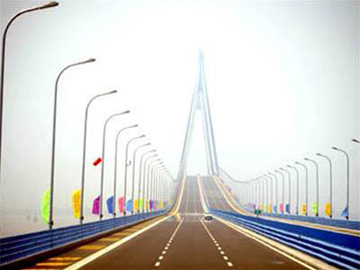
China opened the world's longest cross-sea bridge on May 1st, linking the financial hub of Shanghai with the booming port city of Ningbo with the length of 36km. The 11.8 billion yuan (US$1.7 billion) span will open to traffic on a trial basis at midnight, shortening travel time between Shanghai and Ningbo, two key port cities in China's prosperous Yangtze River Delta, to two-and-a-half hours from four.
2/ The first inter-continent bridge connecting Euro - Asia
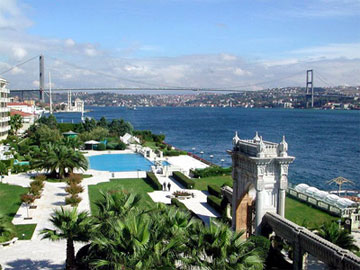
The Bosporus or Bosphorus, also known as the Istanbul Strait, is a strait that forms the boundary between the European part (Rumelia) of Turkey and its Asian part (Anatolia). The world's narrowest strait used for international navigation, it connects the Black Sea with the Sea of Marmara (which is connected by the Dardanelles to the Aegean Sea, and thereby to the Mediterranean Sea). It is approximately 30 km long, with a maximum width of 3,700 metres at the northern entrance, and a minimum width of 700 metres between Kandilli and Aşiyan; and 750 metres between Anadoluhisarı and Rumelihisarı. The depth varies from 36 to 124 metres in midstream. The shores of the strait are heavily populated as the city of Istanbul (with a metropolitan area in excess of 11 million inhabitants) straddles it.
3/ World's Longest Suspension Bridge Opens in Japan
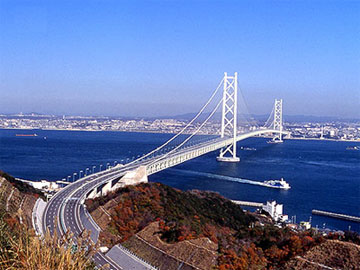
On April 5, 1998, 10 years after construction began, the ribbon was cut to open the world's longest suspension bridge, the Akashi Kaikyo Bridge in Japan. Following a parade of the 1,500 invited guests (including this author) across the bridge, the Crown Prince and Princess of Japan officiated the formal ceremony.
The Akashi Kaikyo Bridge, also known in Japan as the Pearl Bridge, has a record main span of 1,991 meters. The Akashi Kaikyo suspension bridge forms one link in the Kobe-Naruto highway route, which connects the main island of Honshu and the southern island of Shikoku. This route is the eastern-most route of three north-south traffic routes approved in the 1969 comprehensive Japan national development plan to stimulate local commerce and to facilitate the industrial development of the region. A central route, which connects Kurasiki on Honshu Island with Sakaide on Shikoku Island, was completed in 1988. A third route further to the west, the Onomichi-Imabari Route, will connect the Hiroshima greater metropolitan area with the Matsuyama area when completed in 1999.
It cost an estimated 500 billion Japanese yen (U.S. $3.6 billion) to build the bridge. Construction began in 1988 and involved more than 100 contractors.
4/ The widest cable-stayed bridge in the world
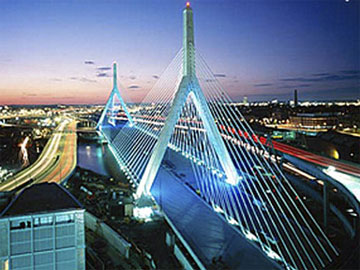
The Leonard P. Zakim Bunker Hill Bridge, part of The Big Dig Project in Boston, is the widest cable-stayed bridge in the world. The Bridge serves as the northern entrance to and exit from Boston. The Bridge is named after civil rights activist Lenny Zakim and the American colonists who fought the British in the Battle of Bunker Hill
5/ Grand Canyon Skywalk

The Glass Bridge Construction of the Skywalk began March of 2004 and was completed by summer 2006.
Upon completion, the Glass Bridge would be suspended 4,000 feet above the Colorado River on the very edge of the Grand Canyon. On May 2005, the final test was conducted and the stucture passed engineering requirements by 400 percent, enabling it to withstand the weight of 71 fully loaded Boeing 747 airplanes (more that 71 million pounds). The bridge is able to sustain winds in excess of 100 miles per hour from 8 different directions, as well as an 8.0 magnitude earthquake within 50 miles. More than one million pounds of steel went into the construction of the Grand Canyon Skywalk.
6/ The heaviest bridge of the world
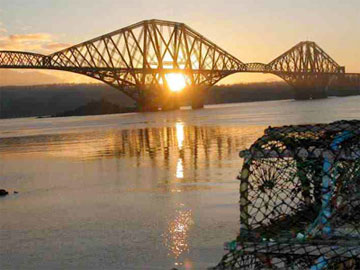
The Forth Bridge is a cantilever, railway bridge over the Firth of Forth in the east of Scotland, to the east of the Forth Road Bridge, and 14 km (9 miles) west of central Edinburgh. It is often called the "Forth Rail Bridge" to distinguish it from the Forth Road Bridge. The bridge connects Scotland's capital Edinburgh with the Kingdom of Fife, and acts as a major artery connecting the north-east and south-east of the country. Described as "the one internationally recognised Scottish landmark", it may be nominated by the British government as a UNESCO World Heritage Site.The bridge and its associated railway infrastructure is owned by Network Rail Infrastructure Limited.
7/ The longest bridge of Europe
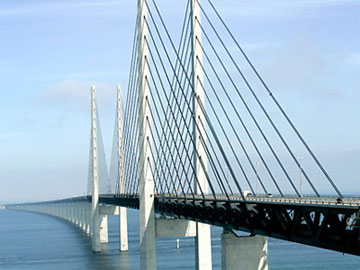
The Oresend Bridge was opened on 1st July, 2000. The bridge links Denmark and Sweden together for the first time since the Ice Age. The new road and rail project covers 10.5 miles (17km) between Malmo and Copenhagen and now physically links together Sweden and the rest of Western Europe.
The ferry that goes between Malmo and Copenhagen takes three-quarters of an hour while travellers using the bridge can get across in a car in just over ten minutes.
The Oresend Bridge took four years and cost £3.3 billion to build. The bridge at 1,624 metres metres, is the second longest suspension bridge in the world. The main bridge pylons are the tallest structures in Sweden, with a height of 203.5 metres. The Oresend Link passes over the artificial island of Pepparholm and through the world's longest submerged tunnel beneath the Danish section of the sound.
8/ Garabit Viaduct - France
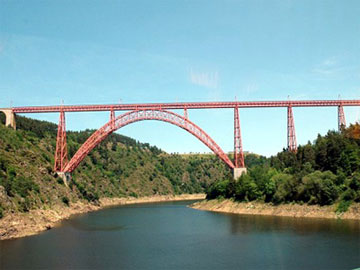
One of the master pieces of Gustave Eiffel in matter of bridges. This bridge, prepared by Maurice Koechlin, is built on the railway line Saint-Flour-Marvejols, Centre of France, line designed in 1877 by Leon Boyer
The iron bridge crosses the Truyere River valley: It is 565m long, 125m high. The whole work is in steel. The main part of the bridge is an arch with a parabolic profile, 165m long, considered, at this time as an incredible audacity. The deck is supported by metallic pulons, 80m high, bearing on masonry abutments.
